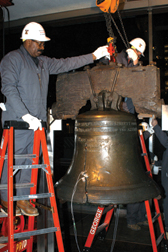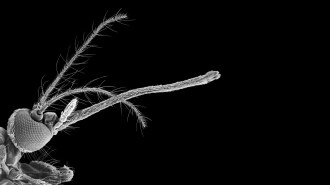- More than 2 years ago
Workers briefly lifted Philadelphia’s 2,000-pound Liberty Bell off its supports last month, giving the icon a taste of the stresses it will encounter this fall when it moves 300 yards to a new home. Last week, the National Science Foundation reported that two sensors clamped to the bell’s famous crack registered displacements near the fracture of just several millionths of a meter.

That’s good news, says Steven Arms, founder of MicroStrain in Williston, Vt., which originally designed the sensors to measure strain in knee ligaments. If a hairline fracture now extending from the main crack were to grow during the move, he says, “the bell could literally fall apart.” Arms plans to monitor the bell’s transfer this fall to make sure it isn’t jostled any more vigorously than it was during the warm-up lift.
****************
If you have a comment on this article that you would like considered for publication in Science News, send it to editors@sciencenews.org. Please include your name and location.





